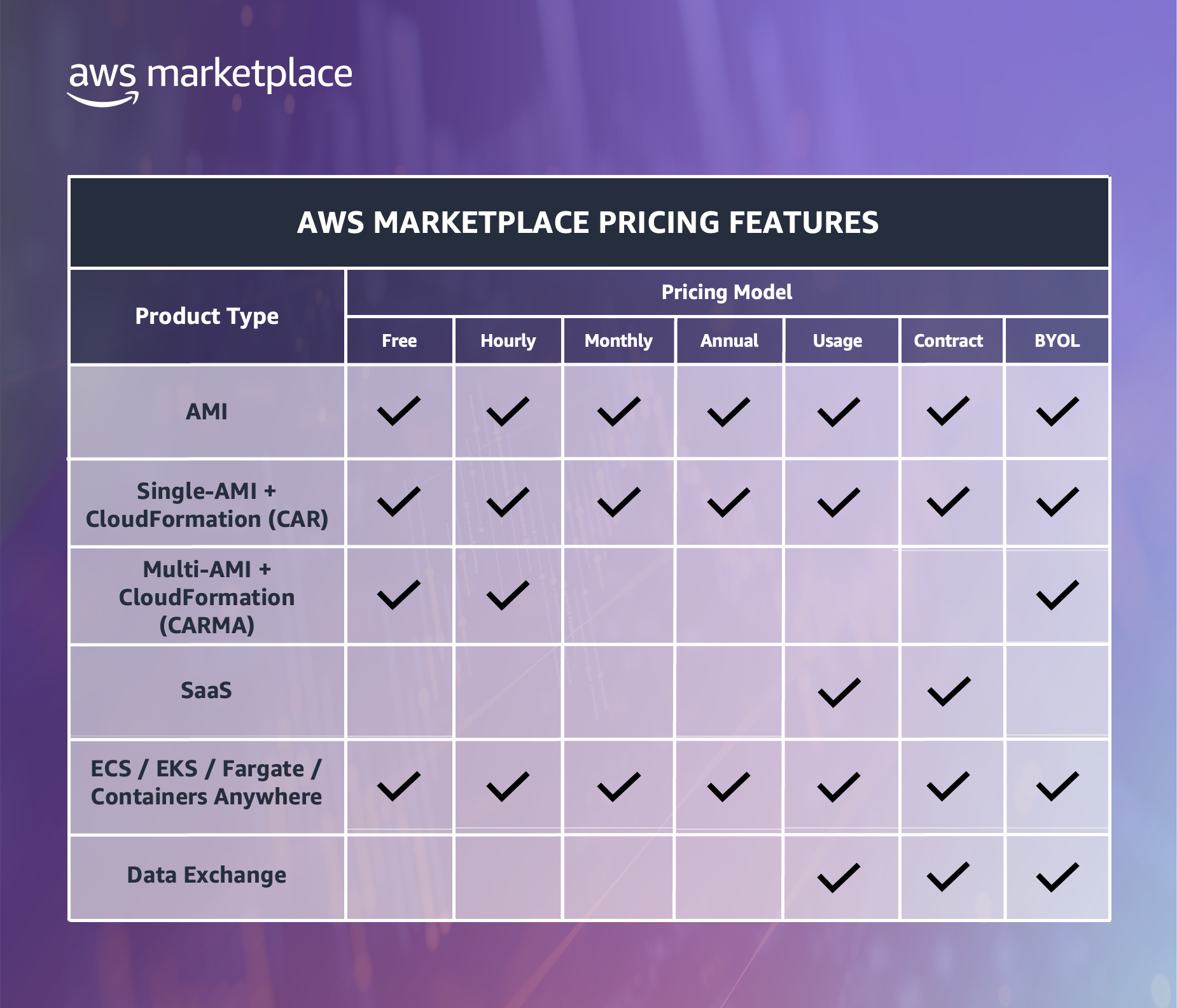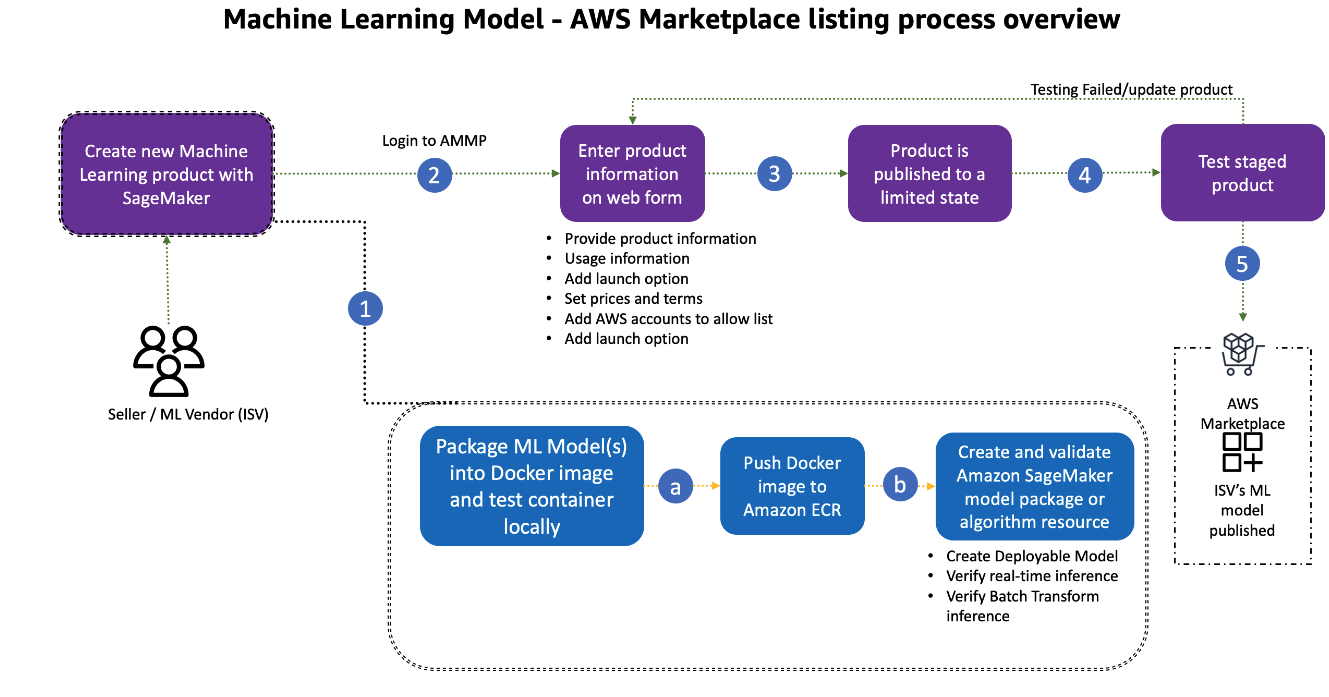How to sell in AWS Marketplace
A guide for sellers to sell and grow their business in AWS Marketplace
Get ready to sell
Register as a Seller
Once you have alignment listing on AWS Marketplace, you'll want to register as a seller. Make sure you meet the seller criteria prior to registering. Before you register, make sure you have the following:
AWS Account ID
Tax information
Banking information
Understand product, pricing, and offer types
There are many product, pricing, and offer types available on AWS Marketplace. Check out what you can list to help you determine which products you should list and sell on AWS Marketplace.

Price and package your solution
Before listing your solution
Build your product listing
Based on the product type you list, there are different steps for how to publish. Check out the guidance from the AWS Marketplace Seller Workshops and videos based on product type. Deploy and distribute your software solutions:
AMI-based products
Amazon Machine Images (or AMIs) are virtual machines that are pre-loaded with your software that your buyers can deploy into their AWS accounts. These virtual machines run on Amazon Elastic Compute Cloud (Amazon EC2).
Check out the AWS Marketplace Seller Workshop on listing and pricing your AMI-based products on AWS Marketplace.
Container-based products
AWS Marketplace allows you as the seller to publish containers preloaded with your software that your buyers can deploy into their AWS accounts. You can configure your container applications to deploy onto various container orchestration services including Amazon Elastic Container Service (Amazon ECS) , Amazon Elastic Kubernetes Service (Amazon EKS) , AWS Fargate , and on-premises using Containers Anywhere.
Video: Deploying AWS Marketplace Containers on Amazon ECS Clusters
SaaS-based products
With software as a service (SaaS) products, you deploy and manage software in your AWS account and grant buyers access to the application. You are responsible for managing customer access, account creation, resource provisioning, and account management within your software.
Video: Create a SaaS Product Listing in AWS Marketplace
Check out the AWS Marketplace preparing your SaaS listing course to guide you through the SaaS listing process.
ML-based products

Specialized Offerings
Deliver expertise and data assets:
Professional services products
As a seller, you can offer professional services in AWS Marketplace . You can include services to assess, migrate, support, manage, and train others in how to use AWS services and products in AWS Marketplace.
Data products
AWS Data Exchange is a service that makes it easy for AWS customers to securely exchange file-based data sets in the AWS Cloud. As a provider, AWS Data Exchange eliminates the need to build and maintain any data delivery, entitlement, or billing technology. Providers in AWS Data Exchange have a secure, transparent, and reliable channel to reach AWS customers and grant existing customers their subscriptions more efficiently. The process for becoming an AWS Data Exchange provider requires a few steps to determine eligibility.
Check out eligibility requirements here.
Boost your listing and drive sales
Product integration
Once you create an initial product page from your seller account using AMMP, AWS Marketplace publishes your product at a limited listing, which means it’s only available to your accounts for integrations and testing. You need to integrate your product with AWS Marketplace to identify buyers that subscribe, check for purchase details, send usage reports for billing, and be notified of changes to a buyer’s subscription status. Check out how to do this in the tabs below.
Integrate your product
AMI-based products
For AMI-based products, annual and monthly pricing models don't require integration. Instead, when you submit your AMI to AWS Marketplace, a product code is attached that is used for automatic entitlement checks and billing.
Custom metering and contract pricing models do require an integration. To learn how to do this, checkout the AWS Marketplace Seller Workshop lab.
Video: Publish Amazon Machine Image Products in AWS Marketplace
Container-based products
For containers, you are able to integrate with AWS Marketpalce to track hourly metering, custom metering, and upfront payments. Learn how to do this in the AWS Marketplace Seller workshop lab.
SaaS-based products
With software as a service (SaaS) products, you deploy and manage software in your AWS account and grant buyers access to the application. You are responsible for managing customer access, account creation, resource provisioning, and account management within your software.
There are two ways you can integrate your SaaS product:
Video: AWS Quick Start for AWS Marketplace Serverless SaaS Integration